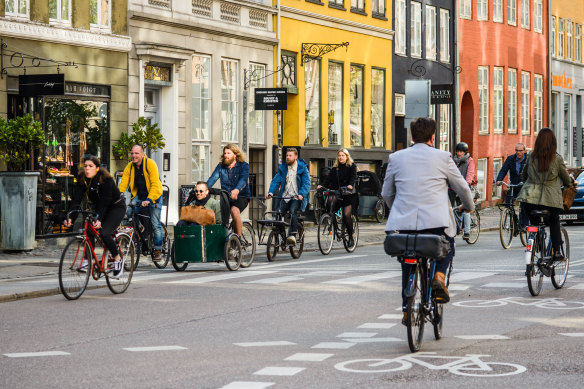Don’t let our dismal cities put you off: Cycling is terrific overseas
Cycling is a great way to immerse yourself in the sights and sounds of a city while providing eco-friendly transport and a workout at the same time.
You also get a sense of freedom that doesn’t rely on transport routes and times, and your journey will likely be quicker than on public transport. But why hurry? It’s easy to dismount and explore further, or simply take in your surroundings, as the spirit takes you.

Ilustration: Greg StraightCredit:
Don’t be put off by the dismal experience of cycling in most Australian cities. Many cities overseas have spent millions on improving cycle lanes and encouraging locals and tourists to get on their bikes, making this an increasingly agreeable way to get around.
In 2020 alone, Europe spent €1 billion ($1.6 billion) on cycle-related infrastructure, including the addition of another 1000 kilometres of cycle paths. Even places with so-far modest cycle ways, such as Barcelona, Lisbon, Krakow and Milan, have now set about improving and extending their networks.
The best places for cycling offer outstanding facilities, such as Copenhagen (where a third of residents pedal to work) and Amsterdam, where 40 per cent of people cycle on any given day.

A third of residents cycle to work in Copenhagen.Credit: iStock
In San Francisco, all public transport in the city has space for carrying bicycles. In Montreal, a third of the 640 kilometres of cycle ways are completely separate from roads, and a third cleared of winter snow. And in places such as the Netherlands and Switzerland, many train stations offer rental bikes.
Cycling saves you money. Abandon the hop-on hop-off bus and look out for public bicycle (and scooter) share systems that offer a low-cost, flexible and convenient way to get around and do your sightseeing.
Some are entirely free, some require only a refundable deposit, but even those that charge will likely cost just a few dollars for the entire day.
Take the Velib system in Paris as an example. You can rent a bike for €1 ($1.60) per half-hour, or €2 for an e-bike. Thirty minutes is ample time to get between most major sights.
There’s no need to hang onto your bike, since the city has 20,000 bicycles at 1400 docking points and you’ll easily find another. The Velib app (or a free tourist-office map) details all the stations, and machines have English instructions.
Europe’s share-ride systems are mostly council run, but elsewhere you might find privately funded operations. These are generally dockless, with bike locations indicated on an app and bicycles unlocked and paid for using a QR code.
In Beijing, for example, Didi Bike and Hellobike run systems with their own differently coloured bikes. Rides cost as little as 20¢ per half-hour.
The world’s most extensive bike system is in Hangzhou, which has some 3000 stations, 116,000 bicycles and over 4000 kilometres of cycle lanes. The first hour of rental is free, although you’ll need a ¥200 ($40) refundable deposit. Great deal, and no better way to get around.
Sign up for the Traveller Deals newsletter
Get exclusive travel deals delivered straight to your inbox. Sign up now.